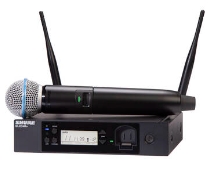Wireless Mics and FCC Rules

[January 2024] Most broadcasters use wireless microphones in some parts of their operations. However, from studio operations to remote broadcasts, broadcasters (and many churches) may need to plan for buying new gear. Here is what you need to know:
Sometime in the First Quarter of 2024, the broadcast and microphone industries expect new regulations that will affect all users of wireless microphones.
It appears the Commission is getting ready to act on the Notice of Proposed Rulemaking adopted and released on April 22, 2021.
This is FCC’s ET Docket No. 21-115, which is captioned “Amendment of Parts 15 and 74 of the Rules for Wireless Microphones in the TV Bands, 600 MHz Guard Band, 600 MHz duplex Gap, and the 941.5-944 MHz, 944-952 MHz, 952.850-956.250 MHz, 956.45-959.85 MHz, 1435-1525 MHz, 6875-6900 MHz and 7100-7125 MHz Bands.”
Comments and replies on 21-115 were scheduled and completed in 2021. This has given the wireless microphone industry some time to develop strategies for, among other things, defending access to spectrum under 1 GHz and exploring alternatives.

A NEW MICROPHONE TECHNOLOGY
At the center of the NPRM and potential regulations is the Wireless Multi-Channel Audio System (WMAS).
WMAS has been recently developed to meet the growing demand for wireless technologies to share the available spectrum.
This is welcomed by the FCC, which has been on a continuing effort to stress spectrum efficiency. The significant changes in the TV spectrum, for example, have reduced the frequencies used by many wireless microphone models from 83 to 37 channels – especially those in the 600 MHz band and up.
With the more tightly packed TV spectrum, places for wireless microphones are reduced. Hence, the FCC wants to update the existing LPAS (low-power auxiliary station) and wireless microphone rules to reflect the state of the TV spectrum following the Incentive Auction, as well as coordinate references to international wireless microphone standards.
THE EFFECT OF 21-115
Ultimately, it looks like the FCC will revise the U.S. National Spectrum Strategy to add controls, so WMAS devices would operate on the TV bands and other LPAS frequencies bands on a licensed basis.
Although WMAS is a wideband technology – as opposed to narrowband technology used in current/legacy systems – co-existence is not complete.
This is why the many parts of the wireless microphone community have then converged on support of technologies that deliver greater spectrum efficiency than what is currently available with narrowband technologies, although users in many cases will need to purchase new gear.
Prakash Moorut, Global Head of Spectrum & Regulatory Affairs for Shure specifically saw the need to protect what he called “Program Making & Special Events” (PMSE) products – wireless microphones and in-ear monitoring systems, especially those operating near 1 GHz.
WHAT THE MANUFACTURERS ARE DOING
In its recent letter (12/6/23) to the FCC, Shure Incorporated noted the need to develop rules that protect existing users to the extent possible.
Shure is one of the companies that took an active participation in the regulatory discussions regarding WMAS as the regulatory concepts developed. Shure specifically focused on the wireless microphone issue and offered ideas seeking to protect some frequencies under 1 GHz – both licensed and unlicensed – that have been lost in recent years. One solution suggested is utilizing, for example, a sliding scale of power and bandwidth. Another possible solution they worked on was to explore ways to add comparable propagation characteristics in the 1 to 2 GHz range, to compensate for loss of the lower spectrum.
Overall, the goal is to make WMAS scalable to permit some areas of compatibility with legacy narrowband systems and develop some real-world use scenarios so not all older gear would be forced off the air. Exact technical specifications are a bit in flux as the balance of power, bandwidth, and spectral efficiency are still being discussed among the manufacturers and the FCC.
What does this mean for broadcasters? The final rules may be unveiled by this year’s NAB Show, making it worthwhile to be a bit cautious in purchasing wireless microphone and in-ear monitoring systems until it is known what will continue to be useful, what will be coming on the market, and what it will cost.
– – –
Would you like to know when more articles like this are published? It will take only 30 seconds to
click here and add your name to our secure one-time-a-week Newsletter list.
Your address is never given out to anyone.
